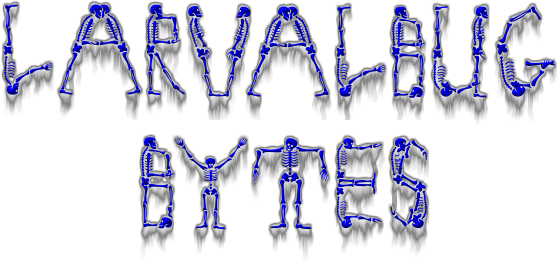
| Volume 20, Issue 10 |  | October 21, 2018 |

|
In this Issue:
|


| Volume 20, Issue 10 |  | October 21, 2018 |

|
In this Issue:
|

For hundreds of thousands of years, humans did without them, but these days shoes are such an important aspect of our lives that there are few these days who do not wear one or another form of foot fashion during each 24-hour period. In fact, so distant have we gone from our more natural heritage that a pair of coverings for the feet can occasionally go for over $15,000,000. Though a perfectly serviceable pair of women's or men's footwear may as yet be purchased at WalMart for under $12, mere Nikes, an extremely popular brand, can go today for tens of thousands of dollars. People are even killed just for their shoes.
Much about a person's biography might be written from the point of view of his or her history with footwear. When we come into the world, most of us get our first pair as tiny booties. When leaving this existence, we go out with a nice pair of shoes on our feet, as if we shall still need them wherever we are off to next. Shoes can be as slim, elegant, and for most purposes delicate as a ballet dancer's or as functional, practical, and durable as thongs made from old tires, the vintage heavy deep sea diving boots one might have used to walk on the ocean floor, or space boots for tramping across the surface of the Moon.
Shoes are evidently so vital that even horses get into the act and have their own specialists employed to fashion and fit or periodically replace them.
Shoes are collectible, and some get into this in an almost crazy way. Imelda Marcos is reported to have stashed away over 3000 pair. One doubts she could have worn more than a fraction of hers.
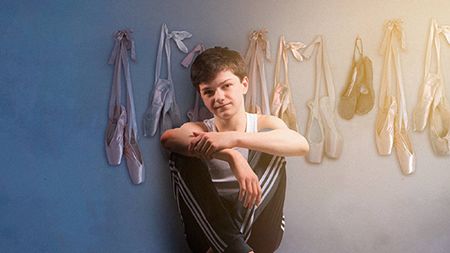 Billy Elliot The Musical (sigtheater.org) |
In contrast, the footwear of Mahatma Gandhi was iconic for its mere functionality, without calling special attention to him. It was as though he had taken simplicity in material possessions as his motto.
Shoes can even be the object of sexual fetishes. I suppose this is harmless enough, far better than molesting children. Yet one might wish these folks would simply get a life!
Shoes are of great metaphorical significance. They can be a mark of empathy: "If you could but walk in another's shoes..." On the other hand, they can be a sign of extreme rejection: "I'll give you a pair of cement shoes," as occurred for a gang member, street name Petey Crack, whose body was found near Manhattan Beach in 2016, his feet encased in concrete.
Shoes may be used as an accepted form of cultural subjugation, for instance with women whose feet were bound since childhood, a terribly painful process, and were thereby considered more attractive, a practice that continued in China for a millennium. In much of this period women with feet longer than 5 inches were said to have poor marriage prospects.
Story or movie plots can hang on the interactions of characters with their shoes, for instance with "Cinderella," "The Man With One Red Shoe," "The Wizard of Oz," "Top Hat," or "Back to the Future, Part II."
In my childhood, Dad's combat boots were a prominent memory, as were his more everyday military shoes, as he was an Air Force officer, and when I was a little kid he expected me most evenings to shine them up for him, take them and his socks off, then replace them with fresh socks and his slippers.
My own shoes then were usually a children's customized variation on leather paratrooper boots, specially fitted and braced to support my feet and ankles in the correct positions, for I was born club-footed, and the feet tended instead to turn so their soles were facing upward or at least at about a 90-degree angle to what is more useful for standing and walking. Such footwear was worn in my case through my early elementary school years. The initial twisting of my feet and legs via casts, orthopedic shoes, and massage felt to me at times as if I were one of those dowsing rods, my spine in this case holding the tension, but I have yet to discover underground water.
As a youngster, I liked Buster Brown shoes once I could wear more trendy fashions. I appreciated too that I could go to the shoe store and look into a neat x-ray machine that would show my feet, including the bones. Very cool, if a bit unsafe by modern standards.
Still later, there was nothing particularly noteworthy about my own shoes. Like many in my state of TX, I have worn cowboy boots, sneakers, sandals, dress shoes, basic training boots, slippers, etc. While up in WI visiting relatives in winter, when there is often snow or mud, I have worn simply galoshes with thick socks. My high arches, residuals from the club-feet, prevent wearing of shoes too inside the wet weather gear. The past few years, plantar fasciitis having set in, I wear lifts in my shoes that conform to the bottoms of the feet and so mostly keep new tendon tears from occurring.
It is time for me to downsize and throw out the shoes I have not worn in years, along with donating or discarding a couple bushel basketfuls of clothes that have been hanging in my closet untouched for at least a decade. Like Imelda, I could do fine with far less. Gandhi probably had the right idea.

Everyone likes to have friends. Associations with other individuals can be pleasant, useful, and sometimes crucial to one's wellbeing. Building relationships is a major factor in the lives of many mammals, including ourselves. And it gets really interesting when the pairing reaches beyond the species boundaries. Innumerable stories about people and dogs illustrate interactions that range from the heartwarming to the amazing, as do accounts of birds and mammals, fish and birds, and even predators and prey.
But what about invertebrates? Considering that insects have little in the way of brainpower, it is obvious that movies such as "Antz" and "A Bug's Life" take a bit of artistic license when it comes to portraying relationships. Well, and the fact that those insects can talk and do a lot of things that most people find challenging. As engaging as the characters appear, they are, remember, just animated fictional creations.
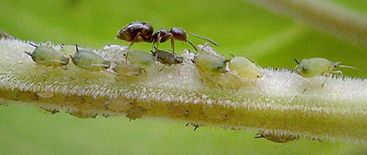 Ant & Aphids |  Ants & Mealybugs |
Real life insects, however, do sometimes have rather remarkable associations, and one taxon stands out as a major player in these situations: ants. There are relatively few highly social insects compared to the multitudes of solitary species. Eusociality is the rule for termites, but it is most widespread in the hymenoptera, especially honey bees and the family Formicidae.
Ants are some of the best defended insects. They live in colonies where they enjoy the advantages bestowed by sheer numbers. The female workers and soldiers communicate with each other, have sharp jaws that they readily use against prey and adversaries, and many have stingers (an ovipositor modified to deliver venom, such as formic acid or alkaloids). Anybody who has been stung by the Imported Fire Ant, Solenopsis invicta, knows the effectiveness of such stings.
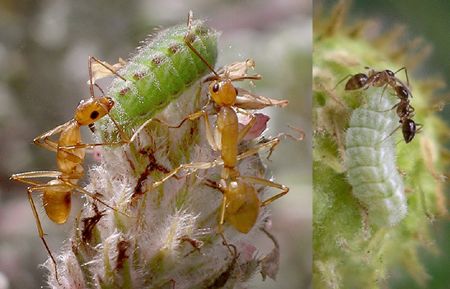 Ants & Butterfly Caterpillars |
A similar relationship with ants occurs among some butterfly caterpillars. Like aphids, the larvae of hairstreaks and blues in the family Lycaenidae, are very slow moving and tend to just sit on their plants while feeding. They, too, ingest more liquid than they need and so generate the sweet waste product that lures ants. It's interesting to note that the ant species attracted to the herbivores range from very tiny to rather large, and there is no guarantee that any particular caterpillar or aphid colony will even have attendants. The association occurs often enough, though, that the advantages have favored its evolution.
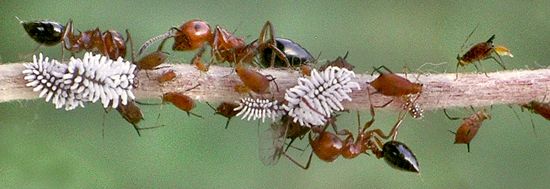 Ants, Aphids & Lady Beetle Larvae |
So what happens if no ants are guarding aphids or if their attentions are inadequate to protect their defenseless little charges? Plenty. There is a reason that aphids have evolved rapid reproduction, which, by sheer multiplication, can usually counter the ravages of predators and parasitoids and ensure the species' survival.
As the ant/aphid relationship developed, so did the aphids' predators' arsenal of ways to deal with the ants. Many kinds of lady beetles specialize in eating aphids. This is why they are a popular biological control among gardeners. Lady beetles are predators both as adults and as larvae. In fact, the immature beetles probably eat more aphids as they grow and develop than the adults who must also spend time mating and laying eggs. Lady beetle larvae usually just crawl up to an aphid and eat it. An ant might object to that, though, and drive the beetle away. Some lady beetle larvae have a counterstrategy and produce waxy coverings that chemically hide them from the ants. The secretions the beetles produce not only look a lot like those of mealybugs but evidently also fool the ants, as they ignore these interlopers that are feasting on their aphids. The aphids, in turn, seem to have no clue that their neighbors are being gruesomely devoured and they are probably next. The "wolf in sheep's clothing" seems an apt metaphor here.
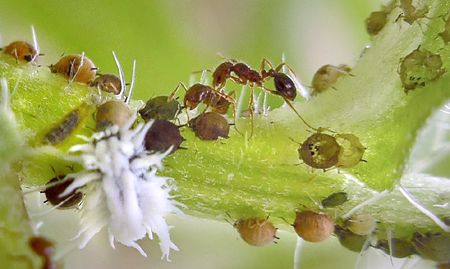 Ants, Aphids (Alive & Parasitized), Lady Beetle Larva & Flower Fly Maggot |
In our sophisticated anthropomorphic imaginations we can easily project how horrible all this carnage is, sympathizing with the victims and their not-always-so-effective protectors, but in the entomological realm, it is more like business as usual. Remember, they are just bugs.


One of the holiday events that took place when Larry and Val visited with Tom, Vicky, Lucas, Isabella, and Amie in Turtle Lake, WI, in late Dec., 2009, was a trip to a hair stylist. Vicky and her daughters donated their excess fur to "Locks of Love," a charity that makes wigs for cancer patients. The whole affair was witnessed and recorded by a cadre of amateur photographers, including Val (who took the photo), Lucas, Larry, and Tom. This shot catches the moment when Isabella and her ponytail dramatically parted company.

| (The Terra Tabloid is a venue for the discussion of issues pertaining to the past, present, and future of our planet and human interaction with it.) |
Scientists say the usual methods of growing animals to feed humans contribute more greenhouse gas to the atmosphere than gasoline fueled cars, ships, trucks, and planes combined. As typically raised, chickens, cows, and pigs produce vast quantities of carbon dioxide and methane, both threatening runaway climate change if current trends continue.
If we want to be environmentally sensitive and so switch from carbon-based fuel vehicles to electric, yet still eat a lot of meat, we have done less than half what we could to stave off further global warming. Even eating cheese and other dairy products or eggs but not the flesh of beef or poultry does not exempt us from damaging the environmental. After all, egg laying fowl and dairy cattle or goats still need to fart and do so in prodigious quantities. Runoff of nitrogen used in raising food for the animals we eat also is a major contributor to environmental degradation. Avoiding meat and dairy, then, is the most effective way individuals can stop harming the biosphere. Vegan diets have been found to be up to 84% less harmful to the environment than characteristic American vittles. We may not even be safe limiting our animal protein to fish. Catfish aquaculture, for example, is about as polluting as beef production, creating roughly twenty times as much greenhouse gas as small capture fisheries or farmed mollusks. The trouble is, though, on average we just love our meat!
Help for our inner carnivores may be on the way though. From "Good News Network," (New Cow Feed Causes Fewer Farts, Say Swiss Inventors Who Want to Curb Global Warming, by McKinley Corbley, 10/4/18), we learn that a Swiss firm, Agolin, is marketing a specialized type of feed for cattle that reduces their fart generation by 10%. The feed inventors have already begun supplying the food for about 4% of European cattle. Since a single cow produces three tons of greenhouse gas annually, Agolin's positive contribution is becoming substantial.
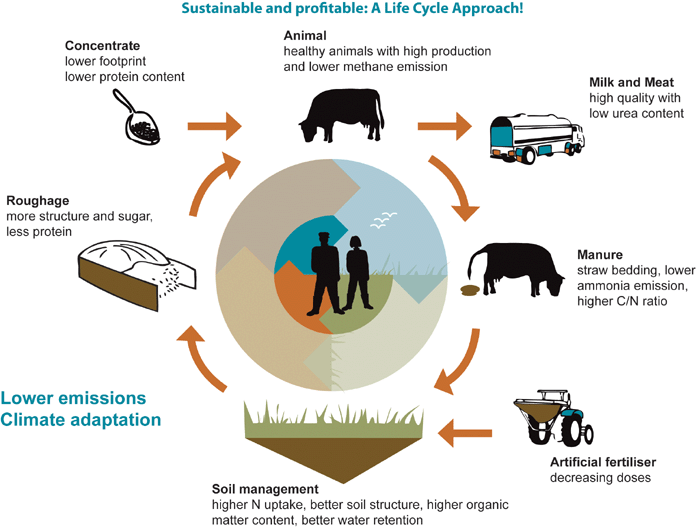
Even more benefit may come from the next item of helpful news on this front. In labs around the world scientists are developing ways to grow meat from animal cells synthetically. Cultured meat has up to a 45% lower carbon footprint than conventional methods of meat production. Recent developments with synthetically grown chicken cells are especially promising. In the next several years they might contribute significantly to things like chicken pot pies or chicken tenders.
Insects also are a large potential source of protein, once efficient means are found to collect them, remove their exoskeletons, and mix them with other foodstuffs in a manner to make them palatable for the initially squeamish eater. They are often available in vast numbers, ripe for harvesting. The carbon footprint of a pound of mealworms vs. the same weight of beef is miniscule. Twenty years ago, few outside the orient were attracted to Sushi, yet now it is in demand. Similarly, new ways of presenting and popularizing insect protein will likely be developed. In the future, just as cornmeal looms large in the plant-based food industry, so bug butter may be part of later generations' staple diets, or, how about cicada fried rice? Mmm, good!
A huge contribution to reducing our average edible contribution to global warming could come from simply being more efficient with the food already produced. Estimates range from 30-50% for the amount of food that is wasted in our country. Were we to cut that down to 20%, a vast savings in greenhouse gases production could be achieved. Since there are countries where the food waste is far less than here, it surely can be done, though some of our habits might need to change. One way to help cut down on food waste is to follow France's example and make throwing out good food illegal. Instead, there it must be either composted or donated.
Another interesting idea in reducing the carbon footprint of our diets is to simply lower one's average meat consumption. Americans often exaggerate the amount of protein we need. Our systems likely evolved in a time when we were mainly hunter gatherers. In contrast to how things are frequently depicted in the movies, that probably meant we ate only a small part of our total nutrition as mammal flesh. Nuts, beans, tubers, seafood, leafy plants, fruits, grains, birds, mushrooms, insects, eggs, and small land animals eaten sparingly seem to have been the more routine fare on which folks survived and were healthiest. One way to get closer to a more natural type diet and help the planet at the same time might be to simply substitute a denser non-animal food, such as an apple or perhaps a serving of mushrooms mixed in a salad for a helping of meat once a week or daily.
As human populations grow, there will need to be more efficient means of feeding ourselves. To do so with less expenditure of energy, more nutritional gains for us, and less negative impact on the environment will increasingly be a matter of necessity. Happily, there are a variety of means toward achieving these ends.


Centipedes might look a lot like millipedes but there are some major differences, not the least of which is that they are in different classes; centipedes are in chilopoda while millipedes belong in diplopoda. Millipedes are slow moving scavengers while centipedes, such as the stone centipede (Lithobius sp.) shown here, are speedy predators. Millipedes have two pairs of legs per segment while centipedes have only one. And centipedes cannot curl up in a spiral like millipedes can. If you handle a millipede, the worst that can happen is you get some stinky goo on your fingers because that is a millipede's defense; it oozes out of pores on their sides. Centipedes, though, have venom and can bite, so they are better left alone. The main similarity is that both kinds of arthropods live under rocks.

The recent stock market volatility may have given investors the jitters, with the Dow down 5.2% in only two days, 10/10/18 through 10/11/18, and still down 4.3% as of this writing (10/18/18), even after a subsequent rally or two. Nonetheless, short-term market sell-offs can reveal value gems. Equities that sport a nice and relatively safe yield compared with their common stock peers, for instance, may be worth at least a second look. Everything else being equal and excluding shares of a few super growth companies like the early Apple, Amazon, or Netflix, a stock that pays investors more for holding its shares will on average also appreciate more in price. A dip such as we have seen with the Dow, S&P 500, and Nasdaq this month can offer stocks at a discount relative to their dividends. The trick then is to avoid the many that are down deservedly and so winnow out better picks from among a large supply of depreciated assets.
The stocks below have larger than usual dividends, positive levered free cash flow, dividend payout ratios of 0.60 or less, and debt to equity of 0.99 or below. They each also represent portions of successful businesses, so one can likely benefit from both share price appreciation and noteworthy annual yields. Taken together, a portfolio of these five has a dividend of 3.0%, almost as high as the current 10-Year Treasury yield of 3.2%, yet government debt assets compared with stocks tend not to beat inflation. From a real return perspective, one is actually penalized by holding bonds or bond funds.
| Company | Ticker Symbol | Recent Price | Dividend Yield |
|---|---|---|---|
| Cincinnati Financial Corp. | CINF | $75.75 | 2.80% |
| Cracker Barrel Old Country Store, Inc. | CBRL | $158.53 | 3.15% |
| Ituran Location and Control, Ltd. | ITRN | $34.40 | 2.79% |
| National Healthcare Corp. | NHC | $75.58 | 2.65% |
| Prudential Financial, Inc. | PRU | $99.70 | 3.61% |
Cincinnati Financial Corp. is a holding company profiting from subsidiaries' and agencies' marketing of property casualty insurance, life insurance, and investments through 32 U.S. States.
Cracker Barrel Old Country Store, Inc. profits from a large number of popular restaurants and retail venues. It appears to offer decent fundamentals and a consistently successful business model.
Ituran Location and Control, Ltd., is an Israel-based company that provides stolen vehickle tracking and recovery, wireless communication applications, and misc. other services. It is a small-cap with seemingly good growth potential.
National Healthcare Corp. profits from providing long-term assisted living vs. independent living health care center services. This is another small-cap stock with good prospects.
Prudential Financial is a financial services company with global operations and profits from the marketing of a wide array of investment services or products.
While I have confidence in the stocks cited here as long-term holdings, I am not as sure of the timing. They could do well despite the present condition of the U.S. stock market, yet that market overall, in spite of a recent decline, still looks overvalued to me. Thus, I would recommend these assets mainly for income-oriented shareholders. On the other hand, if the main stock indices were to fall another 6-7% or so, I believe these equities would serve the investor well on a price as well as a yield basis.
| |||||||||

|
Always be careful what you wish for (as if wishing could produce actual results - dream on!); we wanted cooler weather and it has come on with a vengeance. After our temperature dropped almost 40°F in about 24 hours, central Texas received enough rain to flood rivers and wash away bridges. Impressive show of natural forces. May all our readers have a festive Halloween.
|
| For others who may have chanced upon this site, larvalbug bytes is a monthly family-and-investment newsletter, put out by an old codger and sweet thing, with sometimes a little help as well from our engaging pooch, Peri. We invite readers' comments by and would also be happy to readers when new issues are published. Articles and stories from back issues are available in our archives. |

|
Copyright © 2018 by LARVALBUG
"Ghost of Insects Past" and larvalbug web design by Valerie.
